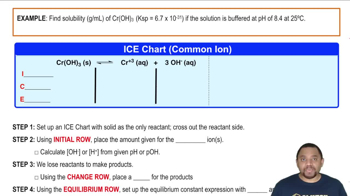Here are the essential concepts you must grasp in order to answer the question correctly.
Molar Solubility
Molar solubility refers to the maximum amount of a solute that can dissolve in a given volume of solvent at a specific temperature, expressed in moles per liter (mol/L). It is a crucial concept in understanding how substances interact in solution, particularly for sparingly soluble compounds like Ni(OH)2. The molar solubility can be influenced by factors such as pH, temperature, and the presence of other ions in solution.
Recommended video:
pH and its Effect on Solubility
pH is a measure of the acidity or basicity of a solution, which can significantly affect the solubility of certain compounds. For nickel(II) hydroxide, Ni(OH)2, an increase in pH (making the solution more basic) can enhance its solubility due to the formation of soluble nickel complexes. Understanding how pH influences the dissociation of hydroxides is essential for calculating molar solubility in buffered solutions.
Recommended video:
Solubility at Buffered pH Example
Equilibrium and Ksp
The solubility product constant (Ksp) is an equilibrium constant that applies to the dissolution of sparingly soluble ionic compounds. For Ni(OH)2, the Ksp expression relates the concentrations of the ions in solution at equilibrium. By knowing the Ksp value and the pH of the solution, one can derive the molar solubility by setting up an equilibrium expression that accounts for the concentration of hydroxide ions, which are influenced by the pH.
Recommended video:




